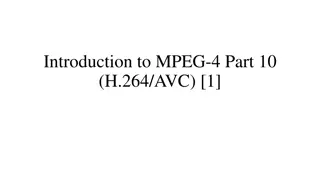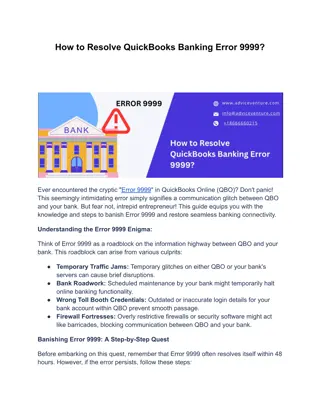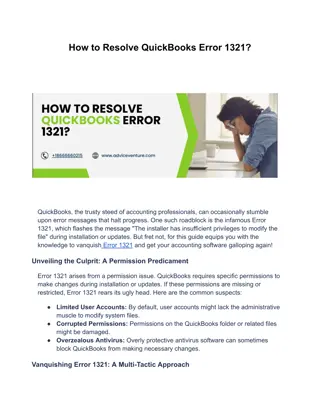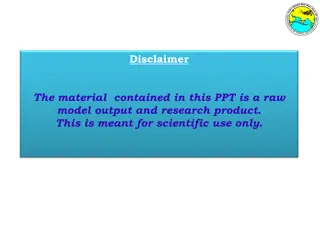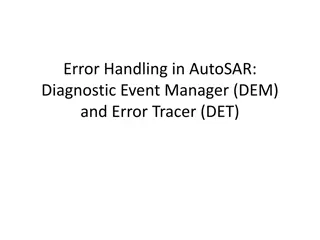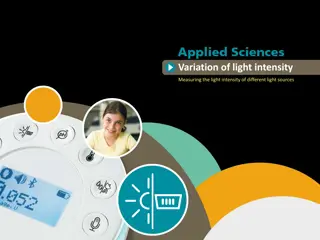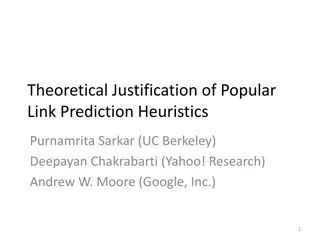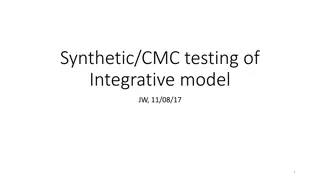Real-time Intensity Forecast Error Prediction Project
This project aims to provide real-time guidance on forecasting intensity errors of hurricanes by using regression formulas based on proxies and atmospheric conditions. The research focuses on relating forecast errors to initial conditions, environmental stability, and dynamical predictors to improve forecasting accuracy.
Download Presentation

Please find below an Image/Link to download the presentation.
The content on the website is provided AS IS for your information and personal use only. It may not be sold, licensed, or shared on other websites without obtaining consent from the author.If you encounter any issues during the download, it is possible that the publisher has removed the file from their server.
You are allowed to download the files provided on this website for personal or commercial use, subject to the condition that they are used lawfully. All files are the property of their respective owners.
The content on the website is provided AS IS for your information and personal use only. It may not be sold, licensed, or shared on other websites without obtaining consent from the author.
E N D
Presentation Transcript
1 Guidance on Intensity Guidance Kieran Bhatia, David Nolan, Mark DeMaria, Andrea Schumacher This project is supported by the NOAA Joint Hurricane Testbed. IHC Presentation 03-03-2015
2 Project Outline Real-time guidance of intensity forecast error Applications of error predictions
3 Project Motivation Bhatia and Nolan (2013) showed that intensity forecast error is often related to the nature of the particular storm and surrounding atmospheric environment. Parameters representing initial condition error and atmospheric stability ( proxies ) are also linked to forecast error. These proxies and environmental conditions can serve as independent variables in a regression formula to predict intensity forecast error.
4 Data Sample Dataset Detail Data Used Hurricane Seasons 2007-2013 (Atlantic Basin) Forecast Hours 12-120 (12-hour increments) Models Evaluated LGEM, DSHP, HWFI, and GHMI Predictors GFS output obtained from SHIPS text files and proxies Verification criteria Excludes LO , EX , and INVESTS. All models must have verification and all predictors for particular time to be included (homogeneous). Land and no land cases combined.
5 Dynamical Predictors Initial and forecast intensity Initial % GOES Cold Pixels GOES IR Brightness Temperature Forecast average and 0 hour: 700-500 hPa RH 200 hPa divergence 850 hPa vorticity Potential intensity Storm speed Latitude Longitude Sin(shear direction) Shear magnitude (850-200 hPa) Ocean heat content
6 Initial Condition Error and Atmospheric Stability Predictors: Standard deviation of ensemble forecast intensity Deviation of the intensity forecast from ensemble mean (absolute value for AE) Deviation of the track forecast from ensemble mean Forecasted intensity change (absolute value for AE) Previous 12-hour intensity change Previous 12-hour error Initial and forecasted distance to land
7 Methodology: Multiple Linear Regression y = 1 * x1 + 2 * x2+ + M * xM + Independent variables (x s) are proxies and synoptic parameters Dependent variable (y) is absolute error (AE) or bias M is the number of predictors is an intercept included to account for model biases
8 Methodology: Multiple Linear Regression Dependent and independent variables are normalized Separate regressions performed for each forecast interval (12, 24, , 120 hr), model, and training period Backward-stepping used: predictor is used in regression model if the probability that the regression coefficient is different from zero exceeds 95% (F statistic) Dependent and independent verification (cross- validated)
9 Predictor and Predictand Transformations AE is bounded by 0, which leads to a positively skewed distribution Box-Cox transformation applied to AE to make it approximately Gaussian before regression is applied To account for non-linear relationships between predictors and forecast error, low order polynomials and Gaussian functions are applied to the predictors and tested For example, 0-hour relative humidity (RH) is fitted using a Gaussian to account for peak error at medium RH values
10 Results ALL RESULTS FOR INDEPENDENT DATASET, CROSS VALIDATION USED FOR 2007-2014
11 R^2 of AE Predictions # of Cases Hours DSHP LGEM HWFI GHMI 12 1884 0.06 0.05 0.09 0.11 24 1683 0.07 0.07 0.06 0.10 36 48 1483 1297 0.06 0.06 0.07 0.09 0.08 0.10 0.12 0.10 60 1138 0.09 0.11 0.11 0.10 72 84 1003 870 0.11 0.18 0.13 0.16 0.15 0.18 0.11 0.10 96 108 746 0.26 0.16 0.15 0.12 652 0.24 0.10 0.17 0.17 120 570 0.23 0.12 0.20 0.19
12 R^2 of Bias Predictions # of Cases Hours DSHP LGEM HWFI GHMI 12 1884 0.16 0.18 0.18 0.16 24 1683 0.24 0.23 0.22 0.22 36 48 1483 1297 0.23 0.22 0.25 0.25 0.26 0.30 0.32 0.32 60 1138 0.25 0.27 0.31 0.33 72 84 1003 870 0.28 0.32 0.29 0.28 0.35 0.38 0.33 0.31 96 108 746 0.36 0.26 0.40 0.31 652 0.37 0.22 0.43 0.28 120 570 0.39 0.24 0.46 0.34
13 Percent Improvement Over AE Climatology Forecasts Hours DSHP LGEM HWFI GHMI 12 7.7 6.1 7.7 8.9 24 9.2 7.9 8.1 8.6 36 48 8.3 6.8 6.3 6.9 9.5 11.0 9.7 10.0 60 8.5 10.0 10.0 10.8 72 84 10.0 15.0 10.1 12.5 11.5 11.5 9.9 10.4 96 17.8 11.2 10.6 12.5 108 120 11.9 10.5 8.1 9.5 11.0 12.0 16.0 18.2
14 Percent Improvement Over Bias Climatology Forecasts Hours DSHP LGEM HWFI GHMI 12 8.0 8.6 9.7 11.4 24 14.9 13.0 11.3 13.9 36 14.2 15.8 14.2 19.4 48 13.9 14.8 15.0 20.4 60 17.9 15.1 16.1 20.9 72 22.1 16.3 20.9 21.1 84 23.8 15.4 23.1 18.6 96 25.7 12.3 25.1 16.6 108 25.2 9.8 26.8 15.5 120 23.2 11.0 30.2 22.8
15 Applications
16 Motivation If model error can be successfully anticipated in certain situations, can we bias-correct the models or weight an ensemble accordingly? Two first attempts to create unequally weighted ensembles can be derived from AE and bias predictions.
18 Methodology For Unequally Weighted Ensemble Technique 1 Bias-correct individual models using bias forecasts and use the mean of the bias-corrected models Technique 2 Inverse-weight individual models using AE forecasts and use the inverse-weighted average as the ensemble mean i.e. if LGEM is predicted to have 20 knots of AE and DSHP is predicted to have 10 knots of AE, trust DSHP s forecast more
20 Conclusions Predictor pool selected using results of Bhatia and Nolan (2013) and added proxies Inputted into a modified multiple linear regression model Multiple linear regression techniques are promising with 2007-2014 independent results showing percent improvement over climatology ranging from 6%-18% for AE and 8%-30% for bias
21 Extra Slides
22 Future Work Testing more proxies Developing nonlinear relationships between predictors and forecast error Varying the length of training period Producing error predictions using probabilistic forecasts Neural networking and nonlinear regression methods may be considered
23 Sample Output File
24 Potential Output Product 1
25 Potential Output Product 2
26 Potential Output Product 3a
27 Potential Output Product 3b
28 COEFFICIENT FILE
29 R=0.75, Skill Score = 31% Absolute Error = -0.16 X (Avg Lat) + 0.1 X (Prev 12 Hr Int Chng) + 0.14 X (Abs. Val. Of Forecasted Intensity Change) + 0.28 X (Dev From Ensemble Mean)
30 R=0.93, Skill Score = 64% Bias = 0.14 X (0 hr Int)+ 0.15 X (Avg Div) + 0.09 X (Fcst Int) + 0.57 X (Dev From Ensemble Mean)
31 Probabilistic Forecasts of AE and Bias
32 Logistic Regression Select a threshold and use to turn predictand into a binary variable Regression formula output is now a probability of exceeding that threshold ?? ln = ?0+ ?1?1+ + ???? 1 ??
33 Methodology: Probabilistic Forecasts AE and Bias were converted to binary and ternary variables AE: Binary threshold = 20 knots, Ternary thresholds= 10 knots and 20 knots Bias: Binary threshold = 0 knots, Ternary thresholds= -20 knots and 20 knots
34 Reliability Diagram Graphical device that shows the full joint distribution of the forecasts and observations Observed frequency of an event is plotted against the forecast probability of an event A perfect forecast system will result in forecasts with a probability of X% actually occurring X% of the time (diagonal line on the graph)
35 60-Hour LGEM AE Tercile Forecast
36 96-Hour DSHP BIAS Tercile Forecast
37 36-Hour GHMI AE Binary Forecast
38 84-Hour HWFI BIAS Binary Forecast
39 Example of Atmospheric Instability Proxy
40 Goerss and Sampson (2014) Results
41 For the Atlantic basin, the percent variance of IVCN TC absolute intensity forecast error that could be explained for this independent sample ranged from 2-5% compared with 4-6% for the dependent sample
42 Boutique Predictors: Gaussian Fit of Relative Humidity vs. AE
43 Boutique Predictors: 2nd Order Polynomial Fit of Dist. To Land vs. Bias
44 Example of AE Transformation
45 Methodology: Nonlinear Fits of Predictors Several predictors exhibiting nonlinear relationships with error were empirically fit Functions tested: Gaussian, second order Gaussian, second order polynomial, and third order polynomial 0-Hour Latitude, 0-Hour distance to land, and 0-Hour Relative Humidity exhibited the strongest non-linear relationships
46 2014 RESULTS
47 Percent Improvement Over AE Climatology Forecasts # of Cases Hours LGEM DSHP HWFI GHMI 12 24 133 117 12.3 19.3 13.2 15.8 14.8 12.9 14.4 13.8 36 102 16.3 19.5 8.2 10.7 48 60 86 74 14.0 17.3 12.6 17.7 9.6 28.9 10.2 28.3 72 64 6.1 8.1 16.4 14.7 84 53 6.1 6.4 13.1 11.1 96 42 8.5 7.6 17.3 18.0 108 34 11.3 -8.9 30.2 28.8 120 28 18.7 8.5 43.5 39.7
48 Percent Improvement Over Bias Climatology Forecasts # of Cases Hours LGEM DSHP HWFI GHMI 12 133 -1.1 -1.5 1.5 0.7 24 117 5.0 3.4 11.1 9.8 36 48 102 13.4 2.4 15.6 14.1 86 16.4 4.3 7.8 6.4 60 74 18.0 5.4 5.9 5.2 72 84 64 53 28.9 23.9 8.6 9.0 6.4 7.9 6.2 7.4 96 42 15.3 0.9 15.2 14.7 108 34 8.0 -1.4 19.6 20.3 120 28 -1.2 7.4 47.3 47.2




